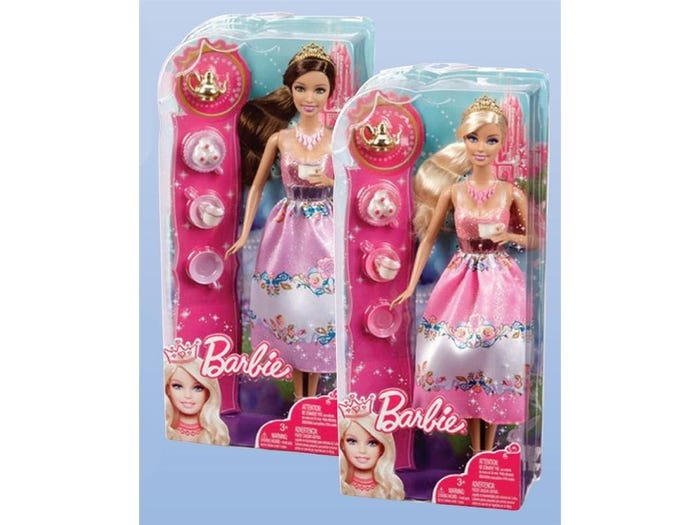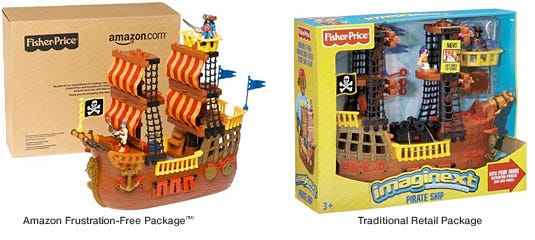Packaging problems: “How do you open this thing?”
I came across a Consumer Reports article that made me laugh. I realize that is probably a strange response to a publication that covers consumer products and services.
November 12, 2012
I came across a Consumer Reports article that made me laugh. I realize that is probably a strange response to a publication that covers consumer products and services.
However, the article I read entitled "Packaging Gotchas" highlighted some of the most "frustrating" packaging that is currently on the market for consumer products. The reason I laughed was because the video that accompanied the article showed one of their workers having a devil of a time releasing Barbie from her plastic packaging due to the molded plastic notches holding Barbie "captive."
 I have two nieces and I can assure you, I've been there. I think one time it took me about 20 minutes to free Barbie from her packaging, much to the annoyance of my nieces.
I have two nieces and I can assure you, I've been there. I think one time it took me about 20 minutes to free Barbie from her packaging, much to the annoyance of my nieces.
Consumer Reports said they received tons of letters, emails, and photos highlighting some of the most "illogical, misleading, and over-the-top packaging" that provided an annoyance to consumers. Here's how Consumers Reports broke down the complaints:
Oysters: This is their term for the hard-to-open products. Oftentimes, these complaints stem from plastic clamshell packaging, which is designed to secure items for shipping as well as discourage theft. But this secured packaging also makes it difficult for consumers who actually bought the items. Consumer Reports said people complain they have to use scissors, box cutters, razor blades, and more just to retrieve the items they bought.
Other oyster headaches? Consumer Reports said cereals in bags that spill out the product when you open it and pharmaceuticals pills in blister packs.
Downsized products: I'm sure we're all too familiar with this one. For example, Maxwell House coffee went from 31.5 ounces to 28. While the parent company Kraft boasts that the coffee has a new flavor lock pack, a reader complained it's hard to taste in 30 fewer cups. Kraft told Consumer Reports it had to either reduce the size or raise the price. Although the company did say the package uses less plastic.
Golden cocoons: This one refers to shipping overwrapping such as using more than the necessary amount of paper, bubble wrap, or airbags to cradle a product. One example Consumer Reports used was Williams-Sonoma shipping its napkins completed wrapped in bubble wrap and placed in a big carton. When the reader received the box, she was surprised that it took that much packaging to ship four napkins.
Frustration-free packaging
Did you know that Amazon offers what it calls 'frustration-free packaging'? I had no idea. But apparently this is to help reduce the amount of wrapping for shipped products and make it easier-to-open.
reduce the amount of wrapping for shipped products and make it easier-to-open.
On its website, Amazon touts that the Certified Frustration-Free Package, "is recyclable and comes without excess packaging materials such as hard plastic clamshell casings, plastic bindings, and wire ties. It's designed to be opened without the use of a box cutter or knife and will protect your product just as well as traditional packaging."
In order to receive the certification, the packaging must be easy-to-open, consist of recyclable packaging, and ship in its own package without an additional shipping box. Amazon says it works directly with manufacturers to box products in frustration-free packages right off the assembly lines, which reduces the overall amount of packing materials used.
But Consumer Reports said frustration-free can still cause costly headaches.
"In online comments, some buyers have said that frustration-free packages didn't protect well enough," the article stated. "One said a computer hard drive was packed so loosely that it arrived damaged, and a replacement showed up in the same condition."
In addition, Consumer Reports shopped for three items on Amazon.com comparing prices for the frustration-free and traditional packaging. Can you guess the result? For every product it researched, the one sold by Amazon in frustration-free packaging was pricier.
An Amazon spokeswoman told the publication that frustration-free items have undergone transit tests to ensure they're properly packaged and that Amazon works with manufacturers and shippers to resolve any issues.
Solving packaging problems
While companies work to come up with solutions to reduce the consumption of excess packaging, they still want to ensure that the product remains undamaged, which is an ongoing debate about how much is too much (or too little) when it comes to reduced packaging.
The concept of 'easy-to-open' was a topic Clear Lam chief marketing officer Roman Forowycz talked with me about at Pack Expo (October 28-31; McCormick Place, Chicago). He said one of the highlights of the company's peel and re-seal lidding film technology is the intuitive easy opening and closing functionality for portion control. The film can be printed and hermetically sealed, eliminating the need for traditional lids and shrink-bands.
"It's a simple packaging that consumers can understand," he said.
I wonder if articles like the Consumer Reports one will prompt manufacturers, retailers and packaging firms to design easier-to-open packages. It would be nice if it were easier to free Barbie from her molded plastic notches.
About the Author(s)
You May Also Like


